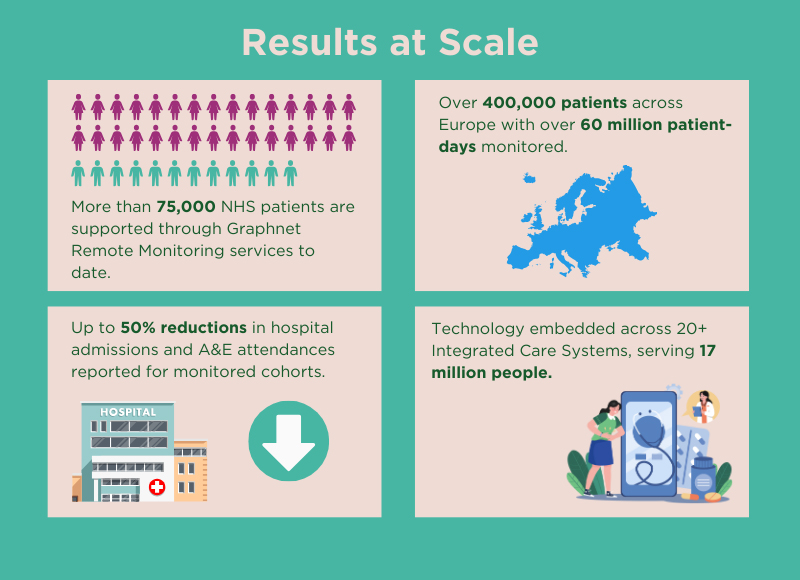Remote Monitoring in the NHS Long Term Plan: Smarter Care, Better Outcomes
24 September 2025
Remote Monitoring in the NHS Long Term Plan: Smarter Care, Better Outcomes
Remote monitoring is now a core part of how the NHS delivers care. Done well, it prevents deterioration, protects capacity, and improves patient experience - all central aims of the NHS Long Term Plan which aims to transform services by embracing new technologies, medicines, and innovations.
At Graphnet, our role is to make this happen at scale: identifying the patients who will benefit most, enabling safe and effective at-home care, and demonstrating real-time impact across entire systems.
Why now?
With growing pressure on both urgent and elective care pathways, the NHS needs new ways to deliver safe, effective, and sustainable services. Digital, preventative, out-of-hospital care has become essential to meeting rising demand and maintaining capacity.
Remote monitoring enables clinicians to identify deterioration early and prioritise patients who need attention today, while empowering others to confidently manage their health at home. This reduces avoidable admissions, protects hospital resources, and supports the NHS Long Term Plan’s shift towards prevention, digital innovation, and care closer to the community.
How remote monitoring works
Graphnet brings Remote Monitoring together with Shared Care Records and Population Health in the only fully integrated approach. This ensures that care is safe, coordinated, and scalable across an entire system, with a focus on:
- Targeting: Use advanced population health insight to identify the right cohorts for monitoring, focusing resources where they will have the greatest impact. This means clinicians can spot at-risk patients earlier and intervene before issues escalate.
- Delivery: Support people at home with simple, clinically led pathways and intelligent triage. Patients are guided to self-manage where appropriate, while clinicians are alerted when direct action is needed, reducing unnecessary hospital visits.
- Evaluation: Measure outcomes and value at every level – patient, service, and system. Real-time reporting shows improvements in patient experience, operational efficiency, and overall system performance, helping NHS teams prove and sustain benefits.

Trusted European Innovation, Delivered for the NHS
To give clinicians and patients a best-in-class experience, our platform incorporates Luscii’s patient-facing technology - ranked No. 1 in Europe and already supporting care in 11 countries - underpinned by OMRON Healthcare’s device ecosystem. With over 350 million blood pressure monitors sold globally, including 2 million in the UK in just the last three years, OMRON bring unrivalled reach and reliability.
Together, this partnership delivers a proven, clinician-designed remote monitoring service that operates at the scale and standard modern NHS pathways demand. It means patients benefit from simple, accessible tools while clinicians have confidence in the data, the process, and the outcomes.
What this means for ICSs and providers
For Integrated Care Systems (ICSs) and providers, remote monitoring is more than a digital tool – it’s a practical way to deliver safer, more proactive, and more sustainable care at scale. By embedding it within shared records and population health management, ICSs gain the insight and headroom needed to meet rising demand while improving patient experience. It means:
- Safer, proactive care – Earlier intervention reduces the risk of deterioration and prevents avoidable admissions, giving patients better outcomes and more confidence in managing their health.
- Operational headroom – Intelligent triage and tailored alerts help staff focus on those who need attention most, reducing unnecessary contacts and creating the capacity to manage growing caseloads.
- System visibility – Live outcome tracking and population-level analytics provide a clear view of performance, supporting service planning, winter preparedness, and value realisation across the system.
Remote monitoring is not an add-on. It is a connected part of modern care – spanning risk stratification, daily delivery, and measurable outcomes – and it is already working across the NHS today.









